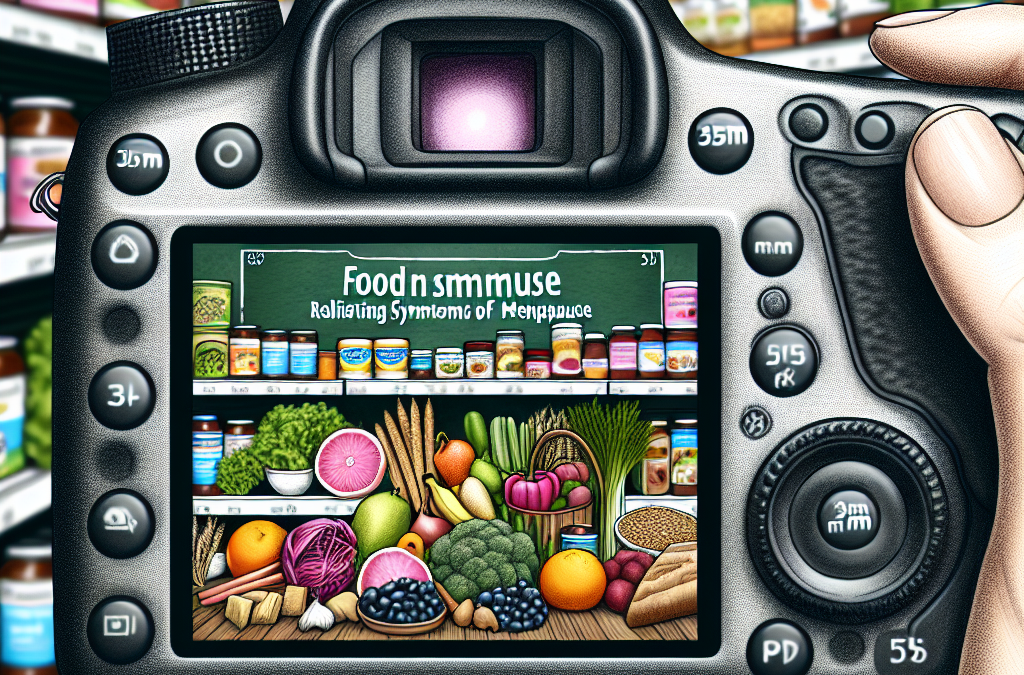Health-Boosting Fruits
Why Fruits Matter
Fruits are like nature’s candy, and I’ll be the first to admit, I can never get enough of them! When it comes to alleviating menopause symptoms, specific fruits pack a punch with nutrients and antioxidants. They help balance hormones and can even elevate your mood, which is a huge bonus during this period of fluctuation.
One of the best examples is berries. Blueberries, strawberries, and raspberries are not just delicious; they are packed with antioxidants that help fend off oxidative stress. Plus, they can help reduce the intensity of hot flashes!
If you’re a fan of citrus, you’re in luck! Oranges and grapefruits are rich in vitamin C, helping to support your immune system and alleviate some of the anxiety that often comes during menopause. So, grab a handful of fruits, and let’s get snacking!
Superfoods: Avocado and Pomegranate
Let’s talk about superfoods. Avocado is my go-to whenever I need a creamy, satisfying addition to my meals. Rich in healthy fats, avocados can help with mood swings by promoting brain health. Plus, they’re so versatile! Toss them in salads or spread them on whole-grain toast.
Then there’s pomegranate. This jewel-like fruit is not only gorgeous but also loaded with phytoestrogens—these are plant compounds that can mimic estrogen in the body. Adding pomegranate juice to your diet might just promote hormonal balance and make you feel fabulous.
I recommend incorporating these superfoods into your daily meals. A simple avocado toast topped with pomegranate seeds can be a game changer, trust me on this one!
Planning Your Fruit Intake
Now that we know what fruits are beneficial, it’s crucial to plan how to incorporate them into your diet. I often prepare smoothies loaded with different fruits, and it’s a delicious way to ensure I’m getting a variety of nutrients.
Let’s not forget the power of meal prepping! Chop up fruits and store them in the fridge for easy access. You’ll find that having fruits readily available can nudge you to snack healthier.
Finally, don’t hesitate to throw some fruits into your salads or grain bowls. Mixing textures and flavors can make your meals exciting while boosting your nutrient intake!
Nutty Necessities
Why Nuts Are Essential
Nuts are one of my secret weapons when dealing with menopause symptoms. Packed with healthy fats, protein, and essential vitamins and minerals, they’re super easy to add to meals or grab as a snack. The best part? They can help shoo away those pesky mood swings!
Walnuts, for instance, are high in omega-3 fatty acids, which have fantastic anti-inflammatory properties. Plus, they’re great for heart health, a major consideration during menopause. And almonds? They’re loaded with vitamin E, which has some evidence backing it up for easing hot flashes.
So, just a small handful of nuts a day can have a significant impact. My trick? I keep a mix of my favorite nuts in a jar on the kitchen counter to prevent me from reaching for less healthy snacks.
Creative Ways to Add Nuts to Your Diet
Being creative with your nut consumption is super fun! I often throw a handful of walnuts into my morning oatmeal or sprinkle some almonds over my salads for added crunch and flavor.
If you’re feeling a little adventurous, how about making a homemade nut butter? It’s easier than you think and tastes heavenly on whole-grain bread or with apple slices.
Don’t forget about nut-based snacks! Trail mixes or roasted nuts can be a flavorful addition to your snacking repertoire. It’s one of those things where once you start, you won’t want to stop!
Portion Control and Balance
While nuts are fantastic, it’s essential to keep moderation in mind. They are high in calories, so just a small serving is generally sufficient. I try to stick to about a handful a day and balance them with other food groups.
Pay attention to how you feel after consuming them. Sometimes an overload can lead to digestive discomfort, and nobody wants that when they’re already managing menopause symptoms.
Incorporate nuts into a broader balanced diet, and they will surely help you feel great. Think of them as a supporting player in the larger roles of leafy greens, whole grains, and lean proteins.
Healing Grains
The Benefits of Whole Grains
Whole grains are your best friends when tackling menopause. I’ve found that incorporating whole grains into my meals has made a real difference in my energy levels and overall well-being. This means switching out refined grains for whole grains like quinoa, brown rice, and whole wheat bread.
These grains are rich in fiber, which is awesome for digestion. They slow down blood sugar spikes, keeping energy levels stable. That’s something I’ve greatly appreciated, especially during those rollercoaster hormonal days!
Plus, whole grains are often fortified with B vitamins, which are crucial for energy and might help relieve some fatigue that comes with menopause. You’ll feel more motivated to tackle the day’s challenges!
Get an Amazing Discount on the Best Certified Organic Whole Food Supplement!
Experiment with Different Grains
Step out of your comfort zone and start experimenting with various whole grains! Quinoa is a fantastic option that I adore. It’s packed with protein and is super quick to prepare. I often use it as a base for salads or as a side dish.
Then there’s farro, which has a chewy texture and nutty flavor. It pairs beautifully with roasted veggies and makes a hearty meal. Don’t be afraid to try things like barley and millet too—they can add a whole new twist to your cooking!
Learning how to prep and cook these grains can be straightforward and will significantly diversify your meals. Plus, you’ll feel accomplished when you try something new and delicious!
Incorporating Grains into Your Meal Plans
Meal planning can save so much hassle during the week, and incorporating whole grains is a breeze! I often batch-cook my favorite grains on a Sunday so that I have them ready for the week.
If you’re not keen on cooking every day, prepared grains can be a good option. Just ensure they have the whole-grain mark! You can easily toss them into salads, soups, or stir-fries.
Lastly, don’t forget to mix up your grains. A variety of grains not only makes your meals visually appealing but also maximizes the nutrient benefits. Who says healthy eating can’t be fun and appealing?
Veggie Vibes
The Importance of Vegetables
I absolutely love my veggie-packed meals! Vegetables are loaded with vitamins, minerals, and fiber—essential elements for proper bodily function, especially during menopause. When I fill my plate with colorful veggies, I know I’m doing my body a solid!
Cruciferous vegetables, like broccoli and Brussels sprouts, help with estrogen metabolism. They contain compounds that support liver function, which means they can help process hormones more efficiently. A win-win in my eyes!
Leafy greens like spinach and kale are just bursting with nutrients. They can help with inflammation and provide a healthy dose of magnesium, which is known to help with sleep disturbances—something many of us face during menopause.
Getting Creative with Veggie Dishes
One of the things I love most is getting creative with my veggies. There’s no shortage of ways to incorporate them into meals! I often make veggie stir-fries or zoodles instead of pasta to mix things up.
Roasting vegetables brings out their natural sweetness and can make them super delicious. Toss some olive oil and herbs, then roast until golden. I could eat a whole tray by myself!
Another fantastic way is to blend them into smoothies. Seriously, throw some spinach in with your favorite fruits, and you won’t even taste it. Sneaky and healthy—a total win!
Finding Your Favorite Veggies
Finding what veggies you absolutely love is key. I always recommend trying a variety to discover what excites your palate. Seasonal vegetables are often more flavorful and fresh too, making them a joy to eat!
Explore local farmers’ markets if you can; they often have unique and fresh options that you won’t find in the grocery store. This is also a great way to support local business!
And don’t be shy about trying new recipes either! There are countless veggie-centric recipes online. Experimenting with spices and cooking methods will help you discover which dishes become staples in your home.
Frequently Asked Questions
1. What are the best fruits to eat during menopause?
Berries, citrus fruits, and pomegranates are all excellent choices! They are packed with antioxidants and vitamins that can help alleviate symptoms.
2. How can I include nuts in my diet?
Try adding a handful of nuts to your morning oatmeal, tossing them in salads, or even making your own nut butter for a creamy spread!
3. What whole grains should I focus on?
Quinoa, brown rice, and whole wheat products are great options. They’re high in fiber and help regulate blood sugar levels.
4. Are there specific vegetables that help with menopause symptoms?
Yes! Focus on cruciferous vegetables such as broccoli and Brussels sprouts, as well as leafy greens like spinach and kale for their nutrient density.
5. How can I make my meals more nutritious?
Incorporate a variety of fruits, vegetables, whole grains, and healthy fats into your meals. Experimenting with different recipes will help keep it interesting!




